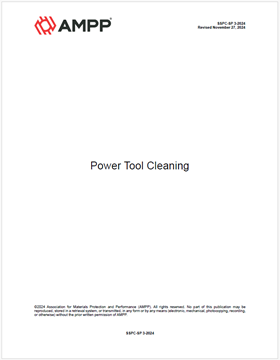Search
Products tagged with 'Standards Benefit For Members'
View as
Sort by
Display
per page
SSPC-SP 5 (WAB)/NACE WAB-1-2015, “White Metal Wet Abrasive Blast Cleaning”
Product Number:
21198-SG
ISBN:
1-57590-323-7
Publication Date:
2015
$109.00
SSPC-SP 5/NACE No. 1-2006, White Metal Blast Cleaning
Product Number:
21065-SG
ISBN:
1-57590-107-2
Publication Date:
2006
$109.00
SSPC-SP 6 (WAB)/NACE WAB-3-2015, “Commercial Wet Abrasive Blast Cleaning”
Product Number:
21199-SG
ISBN:
1-57590-324-5
Publication Date:
2015
$109.00
SSPC-SP 7 (WAB)/NACE WAB-4-2015, “Brush-Off Wet Abrasive Blast Cleaning”
Product Number:
21401-SG
ISBN:
1-57590-326-1
Publication Date:
2015
$109.00
SSPC-SP 7/NACE No. 4-2006, Brush-Off Blast Cleaning
Product Number:
21068-SG
ISBN:
1-57590-102-1
Publication Date:
2006
$109.00
SSPC-SP CAB-1-2024, Abrasive Blast Cleaning of Concrete and Cementitious Materials – Thorough Blast Cleaning
Product Number:
SSPC-SP CAB-1-2024
Publication Date:
2024
$109.00
SSPC-SP CAB-2-2019, Abrasive Blast Cleaning of Concrete and Cementitious Materials – Intermediate Blast Cleaning
Product Number:
SSPC-SP CAB-2-2019
Publication Date:
2019
$109.00
SSPC-SP CAB-3-2019, Abrasive Blast Cleaning of Concrete and Cementitious Materials – Brush Blast Cleaning
Product Number:
SSPC-SP CAB-3-2019
Publication Date:
2019
$109.00
SSPC-TR 2/NACE TR6G198-2023, Wet Abrasive Blast Cleaning
Product Number:
SSPC-TR 2/NACE TR6G198-2023
Publication Date:
2023
$109.00












